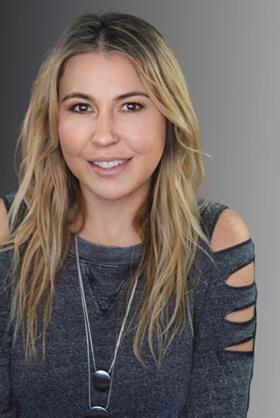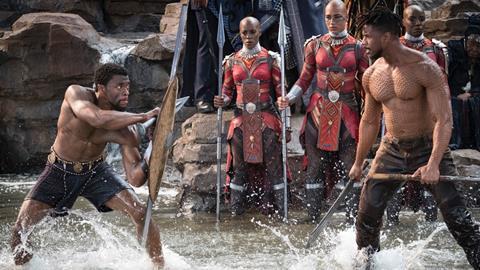Working on over 50 blockbusters and critically-acclaimed feature films, the award-winning colourist Maxine Gervais has always been passionate about creative expression with technology and colour. Now she brings that enthusiasm to IBC.
Maxine Gervais has over 50 movie credits as a colourist, starting with Harry Potter – The Goblet of Fire and reaching new heights recently with Marvel Studio’s smash hit Black Panther and Sony Pictures’ Alpha.

Her plans for the IBC Big Screen session Colour My World were to use clips from both Alpha and Black Panther, and from the sci-fi movie The Meg, to show the processes she applied to grading each job.
“I am fond of the two movies I have done recently for different reasons. Black Panther is a huge box office hit and a pretty unique movie for Marvel because in America it was ground-breaking for having an African-American super hero,” she says. “I worked with the director of photography (DP) Rachel Morrison, so there is a lot of exciting things to talk about.
“Alpha was a project closer to my heart because I had worked with director Al Hughes on Book of Eli,” she adds. “He got me involved from the very beginning when they were shooting, and I got to work with the very talented DP Martin Gschlacht who had shot the movie with the Arri 65. I got to handle some beautiful images.”
Gervais came out of Alpha with a stronger friendship with Hughes and huge respect for Gschlacht, whose first big Hollywood production it was.
She says: “The Meg was also quite successful, and because it is more of an eye candy, fun and silly type of movie it will help to show my versatility in terms of the many kinds of movies I can work on, and the type of looks I can create.”
TV aspects
Has HDR with its wider colour gamut framed a new set of rules for colourists like Gervais?
“HDR is a ‘now factor, but it is still very much an afterthought,” she says. “That’s not the primary target yet: nobody is doing their DI in laser first and then going back to xenon [projection] afterwards. They are all doing their xenon at 48 nits, and then they bring it to Dolby Vision at 108 nits as an afterthought.
“It is always about stretching the content more rather than going down from a bigger target,” she adds. “HDR is driven by either the monitor or the projection. The monitor allows you to see 600 nits or 4,000 nits, while the laser projector is only currently getting to 108 nits.”
As for big TV dramas she says, “Eventually and hopefully [this] will become the primary target for the content and be derived from there. More is happening with HDR at a TV level, where they are starting more to embrace the larger targets, so HDR is derived from that. But when working on a feature the aesthetic is still established at 48 nit projection.”
The latter is generally in DCI-P3 colour space, and sometimes at XYZ colour space, but after that everything gets stretched.
“When you go from 48 nits and have to colour something at 4,000 nits [for HDR] there is quite a difference, and it is hard to manipulate that aesthetic when embracing the HDR and yet being respectful of what the creative had in mind,” says Gervais. “Some creatives embrace it, but some are conservative, so in feature film it is still evolving.”
‘You could argue that the digital intermediate doesn’t apply any more. A lot of people are starting to say colour finishing, because there is no intermediate’
Bigger and better
Gervais is already a fan of the Arri 65, so have the Red Weapon with its Monstro sensor, the Sony Venice and the Panavision Millennium DXL started to feed through better images as well?
“They produce really sharp and amazing imagery. There is a change for the better with new cameras and better sensors moving things along really fast,” says Gervais. “We just keep getting better images, but this is not as ground-breaking as HDR, comparably.
“You can look at the Alexa 65 and the Alexa LF – one is sharper with more beautiful images, but you could produce a similar image with the other cameras,” she adds. “The Arri 65 is right for amazing landscapes but if you do a lot of close-up and tight shots that might not benefit from big format. Cameras are getting better, but it has always been about how the DP wants to shoot a movie.
“Sometimes the director just sends his DP to do all the primary work, and just comes right at the end. Some directors are habitually hands-on, and have to be there the whole time,” she adds.
When Gervais worked on Harry Potter and The Goblet of Fire she was in Leavesden Studios and then Soho for two years. She travelled back to those times to make a key point:
“Back then I would literally colour the dailies as they were shooting. That is when they were watching their dailies back on film, and would scan it all. It was like a whole different beast, and that was really my first DI.
“It is funny to say that now because you could argue that the digital intermediate doesn’t apply any more. A lot of people are starting to say colour finishing, because there is no intermediate. It is just straight digital and digital colouring,” she adds. “People still say DI only because it is a recognisable term.”
‘We just keep getting better [camera] images, but this is not as ground-breaking as HDR, comparably’
Expanding deliverables
When Gervais started out she did a lot of printer lights – a lot of the language was very much derived from historical film labs.
“The fact that [there are] no more chemicals and no more physical prints strengthened the relationship between directors and cinematographers, and also editors,” she says.

“Now we do a lot of VFX types of work, and some shots are going to be VFX DI because it is easier. Things like that were not in DI 15 years ago,” she adds.
“We can do small wire removals and so on, and we put composite layers together to create an effect: we can do some creative transitions on Baselight,” she explains. “We do a lot more than when I started at Leavesden. It is a lot about colour and designing colour, a lot of VFX, a little bit of blending VFX and then the deliverables. These are probably ten times what they were.”
There was a time when there was the DCP, the prints, and home video.
“Sometimes there are about 16 renders for all the different deliverables we have to provide,” says Gervais. “That is 16 versions of the movie, and way bigger than when I started.”
Gervais worked for Discreet prior to becoming a colorist, and used Discreet Lustre in her first job. When she changed facility she did some training on Baselight and there was no looking back. Does she ever want for an app or a new technology?
“At Technicolor I have a lot of support from our colour science team, and I have constant support from FilmLight. When we did Black Panther, because Marvel had some special ways it wanted to work, FilmLight was able to modify many of its tools on the fly just to be able to satisfy the client,” says Gervais. “Every time I have something problematic come up, somebody cracks it for me.”
Does Gervais see herself as an artist or as a colourist? Her colleagues and clients think she is a bit of both.
“My background is art, but you cannot really call yourself an artist. That is the job of other people. I love the word colourist, and while some people now call themselves finishing artists I have reminded with senior or supervising colourist,” she says.
- Read more Interview: Jet Omoshebi, Colourist

























No comments yet